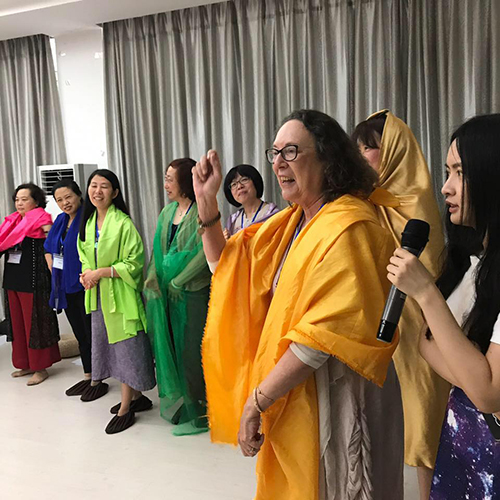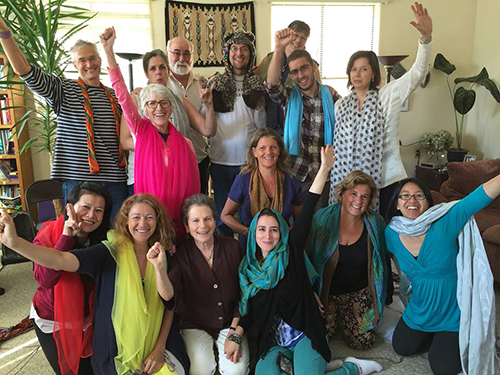TSM offers up-to-date psychodrama for survivors of trauma
By Kate Hudgins, Ph.D., TE
Therapeutic Spiral Model Psychodrama is the most up-to-date method of experiential change for people who suffer from Post-Traumatic Stress Disorder.
The post-trauma response may be rooted in individual personal trauma, or collective trauma, or both. However, the treatment is the same when we use the Therapeutic Spiral Model, or TSM, as we like to call it.
 The Therapeutic Spiral Model is grounded in the latest research in neurobiology and the science of attachment, as well as classic psychodrama, which began its development in the 1920s based on improvisational theater. When a TSM Psychodrama session is directed by a well-trained practitioner, it provides a powerful experience of change in a safe clinical setting.
The Therapeutic Spiral Model is grounded in the latest research in neurobiology and the science of attachment, as well as classic psychodrama, which began its development in the 1920s based on improvisational theater. When a TSM Psychodrama session is directed by a well-trained practitioner, it provides a powerful experience of change in a safe clinical setting.
As I’ve noted in other blog articles, TSM Psychodrama sessions may be conducted online, in families’ living rooms, in psychotherapy offices, community settings, and international work 35 years and counting. TSM Psychodramas have taken place in board rooms and war zones, from therapy practices to the United Nations.
Exactly what is TSM Psychodrama? It is a way to safely experience your internal reality, what psychodrama calls surplus reality, through the sharing of your stories, experiences, hopes, and visions in a community of like-minded people.
It is a way to see the world through a lens of spontaneity and creativity where all possibilities become real, whether it is rebuilding resilience following trauma or co-creating your most precious dream in your life today. TSM calls that living in the world of post-traumatic growth, so that the traumatic events that you have experienced actually become building blocks for greater human development, rather what causes to give up on life.
Unique to experiential practice with trauma, TSM Psychodrama presents and follows a clinical map of the internal roles of a trauma survivor to make sure that action work is safe and effective for all group members, no matter what the size of the group.
The clinical map we call the TSIRA (Trauma Survivors’ Internal Role Atom) provides a guide for all experiential and expressive therapies when working in cultures, populations, and settings around the world. In one of my latest publications, a chapter titled “PTSD Unites the World: Prevention, Intervention, and Training with the Therapeutic Spiral Model,” in Why Global Health Matters, I describe the three stages of prevention, intervention, and training in the International Certification Training Program in Trauma Therapy that applies the Therapeutic Spiral Model to global health.
No matter the setting, we focus on building seven internal roles that we call the “prescriptive” roles. The roles – which focus on skills like neutral observation and containment – are created though new embodied interpersonal experiences to provide an accurate view of your life in the here and now. You also connect with your strengths, many which have been forgotten due to the trauma.
 With the establishment and integration of these prescriptive roles, new energy flows into your body and brain for self-support and clarity of vision.
With the establishment and integration of these prescriptive roles, new energy flows into your body and brain for self-support and clarity of vision.
For many people, connecting to necessary self care and their personal, interpersonal and transpersonal strengths become life-saving moments when they felt they had no spirit left.
The TSIRA teaches people to build self-supporting internal roles for containment, and learn to see the world accurately and with trust. In doing so, people in many settings learn all they need to become fully alive as spontaneous and creative beings. The TSIRA teaches both the ability to find creative solutions to revitalize life and to have easily accessible roles to take when life feels “stuck” and trauma-based roles feel rigid.
With this philosophy, we are able to chart what we call the TSM Trauma Triangle and transform the trauma roles – the next step in TSM Psychodrama sessions. Breaking free of the past roles of victim, perpetrator, and the unique role of self-abandoner, we are able to liberate the true self and live more fully in the present.
Each time I lead a TSM Psychodrama with an Action Healing Team, I find myself in awe, and blessed with the grace of experiencing healing in the moment, with other like-minded people.
When people go in the TSM Psychodrama session, they always bring back the essence of their true self and find they are connected and effective in relationships, work, and self-expression.
About the author
Kate Hudgins, Ph.D., TEP, is the originator of the Therapeutic Spiral Model, which she and her collaborators modified from classical psychodrama to increase safety for survivors of trauma. She has taken this model to 30-plus countries in the past 35 years. Her most recent book is Healing World Trauma with the Therapeutic Spiral Model: Stories from the Frontlines, edited with Francesca Toscani. Learn more about Kate and her international training certification on trauma treatment here.
Dr Kate is a Board Certified Trainer, Educator, and Practitioner of Psychodrama, Sociometry, and Group Psychotherapy with a Ph.D., in Clinical Psychology.
